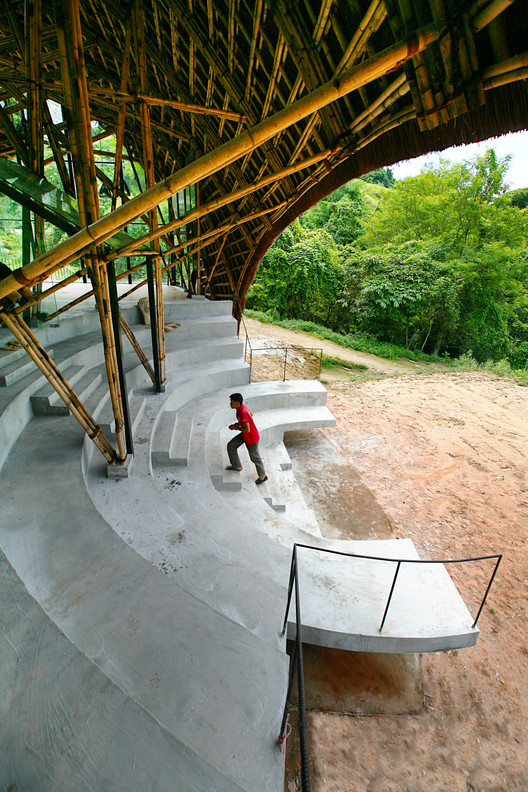AD Classics Moscow Metro Robert Pogrebnoi and Yuriy Zenkivich
2011-08-19 00:00
架构师提供的文本描述。随着19世纪后期的工业发展和铁路建设,莫斯科经历了巨大的规模和人口的繁荣。当时,马车和有轨电车是主要的交通工具,但很快马就不足以为城市的快速扩张提供动力。因此,计划开发一条新的周边环形铁路,将货物运送到整个城市。
Text description provided by the architects. The city of Moscow experienced a huge size and population boom following the industrial development and railway construction of the late 19th century. At this time, horse-drawn cars and trams were the main form of transportation, but soon the horses were not enough to fuel the city’s rapid expansion. As a result, plans were made for development of a new peripheral ring railway that would carry freight throughout the city.
多年后,供乘客使用的地下铁路与原来的铁路连接起来。这些线路很快就把铁路变成了一个繁荣的大都市交通中心,最终成为今天被称为莫斯科地铁的地方。更多关于莫斯科地铁发展后的休息。
Many years later, underground lines for passengers were linked to the original railway. These lines quickly turned the railway into a booming metropolitan transit center, eventually becoming what is today known as the Moscow Metro. More on the development of the Moscow Metro after the break.
在建造符合莫斯科循环布局并与地面原有线路平行运行的地下铁路的过程中,建筑工人不得不克服许多困难的障碍。
In the creation of the underground railway, which was to correspond with Moscow’s circular layout and run parallel to preexisting routes on the ground level, construction workers had to overcome many difficult barriers.
他们将修建隧道的土壤是饱和的沙子、干燥的沙子、含有含水裂缝的粘土、大量的石灰石沉积物和流沙的混合物。此外,还有四条河流穿越未来修建隧道的地点。最重要的是,大部分工作都是手工完成的。虽然道路上有许多障碍,但城市愿意寻求解决办法来克服这些障碍,因为如果铁路成功,它将缓解城市表面的交通拥挤。
The soil that they would be creating tunnels through was a mixture of sands saturated with water, dry sands, clays with water-bearing cracks, massive limestone deposits and quicksand. There were also four rivers crossing through the points where the future tunnels were to be built. To top it all off, most of the work was to be done by hand. Although many obstacles stood in the way, the city was willing to seek solutions to overcome them, for if the railway were successful, it would ease the heavy traffic flow at the surface of the city.
莫斯科地铁的大部分建设分五个阶段完成。第一座于1935年建成,全长11公里,包括13个车站。第二阶段的建设以其大众化的装饰艺术风格和车站艺术作品中的社会主义信息相结合而闻名。随着建设进入第三阶段,由于第二次世界大战,建筑工程被推迟,战争主题取代了车站建筑设计中的社会主义主题。在此期间,地铁站也被用作防空洞和斯大林公开宣布的场所。
The large majority of construction for the Moscow Metro was completed in five stages. The first was completed in 1935, ran 11 kilometers and included 13 stations. The second stage of construction is notable for its popular art deco style combined with socialist messages in the stations’ artwork. As construction continued into the third stage, building work was delayed due to World War II, and war motifs replaced the socialist ones in the stations’ architectural designs. During this time, metro stations were also used as air-raid shelters and venues for Stalin’s public announcements.
战后,第四阶段的建设开始了。莫斯科地铁的精心设计工作被认为在这一阶段达到了顶峰。
After the war, the fourth stage of construction began. The elaborate design work of the Moscow Metro is considered to have reached its peak during this stage.
更多的车站在冷战期间开放,标志着莫斯科地铁建设的第五个也是最后一个主要阶段(这一阶段的建设于1959年结束)。
Even more stations opened during the Cold War, marking the fifth and final major stage of the Moscow Metro’s construction (construction in this phase ended in 1959).
第五阶段建造的空间站进入地球最深处,因为它们计划在发生核战争时加倍作为掩体。然而,由于斯大林的继任者赫鲁晓夫(Khrushchev)倾向于采用一种更实用的设计方法,所以在他的时代建造的电站缺乏以往的奢华。许多人看起来非常相似。他们也是用更便宜的技术建造的,而这些技术往往不适合铁路环境。
The stations built in the fifth stage run deepest into the earth, as they were planned to double as shelters in the event of a nuclear war. However, because Khrushchev, Stalin’s successor, favored a more utilitarian design approach, the stations that were built during his time lacked the extravagance of previous ones. Many were made to look very similar to one another. They were also built with cheaper technologies that were often ill-suited to the railway environment.
每个地铁车站的设计都适应了该地点的地理限制和建造的历史背景。莫斯科地铁的每个车站不仅都有独特的设计,而且也是世界上第一个完全面对花岗岩和大理石的车站。反光的石墙、高高的天花板和精致的枝形吊灯,意在提醒人们斯大林为他的人民创造了什么,以换取他们的牺牲。他们的设计是为了反映他对民族主义、权力和财富的外在表现的倾向。
The design of each of the Metro’s stations was adapted to the geographical constraints of the site and the historical context during which it was built. Not only did each station of the Moscow Metro have a unique design, but the stations were also the first in the world to be completely faced with granite and marble. The reflective, polished stone walls, high ceilings and elaborate chandeliers are meant to serve as a reminder of what Stalin created for his people in return for their sacrifices. They were designed to reflect his inclination toward outward expressions of nationalism, power and wealth.
今天,莫斯科地铁拥有超过300公里的铁路、12条不同的线路和182个车站。平均每天有660万名乘客,这是世界上第二大使用最频繁的快速公交系统。莫斯科地铁不仅是俄罗斯第一条地铁系统,还是一座重要的建筑纪念碑,与俄罗斯丰富的历史和文化有着紧密的联系。
Today, the Moscow Metro has over 300 kilometers of railways, 12 different lines and 182 stations. With an average of 6.6 million passengers each day, it is the second most heavily used rapid transit system in the world. Much more than just Russia’s first underground railway system, the Moscow Metro is an important architectural monument with strong ties to the country's rich history and culture.
 举报
举报
别默默的看了,快登录帮我评论一下吧!:)
注册
登录
更多评论
相关文章
-

描边风设计中,最容易犯的8种问题分析
2018年走过了四分之一,LOGO设计趋势也清晰了LOGO设计
-

描边风设计中,最容易犯的8种问题分析
2018年走过了四分之一,LOGO设计趋势也清晰了LOGO设计
-

描边风设计中,最容易犯的8种问题分析
2018年走过了四分之一,LOGO设计趋势也清晰了LOGO设计








































































